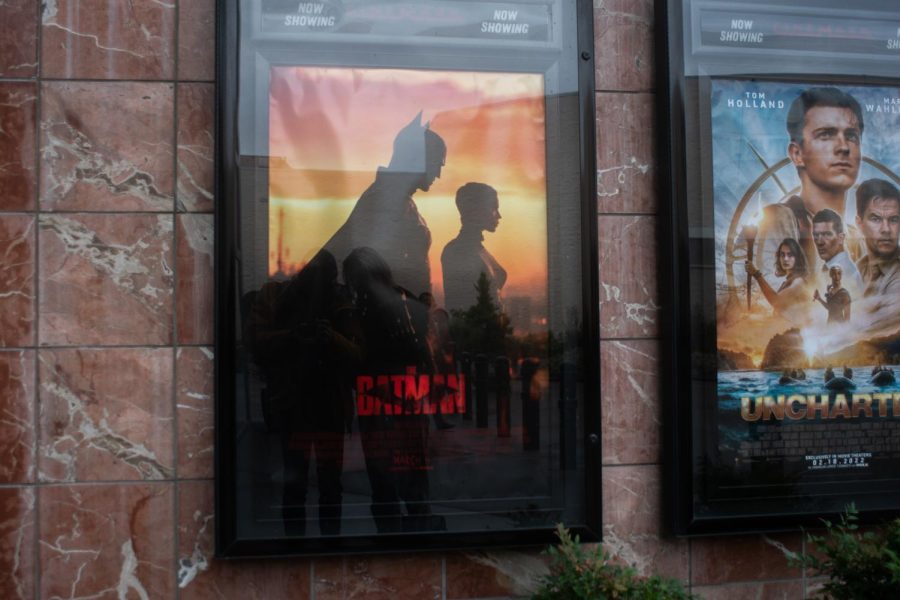After Nearly a Decade, The Dark Knight Flawlessly Rises In a New Light
“The Batman” is the first solo live-action Batman film to hit theaters — and HBO Max on April 19 — since the 2012 release of Christopher Nolan’s “The Dark Knight Rises.”
March 16, 2022
Heavy breathing, a shaky first-person camera angle, and an ominous rendition of the “Ave Maria” open director Matt Reeves’ most recent film to set the scene — and just barely prepare the audience — for the next two hours and 56 minutes that make up “The Batman.”
I’ll admit that in the months before its release, I feared that I would be disappointed in the new film in light of the major success of prior versions from the likes of Christopher Nolan, Tim Burton, and others. But, after having seen it three times already, I can conclude that “The Batman” rises above and beyond its predecessors. With its unique and creative deliverance of the same seemingly overdone story, set of iconic characters, and its new approach to the superhero genre, this is perhaps my favorite Batman adaptation — and superhero film — of all time.
From the get-go, what stood out the most was the film’s darker and more serious tone. Reeves’ film, with its callous depiction of characters, brutal fight sequences, and disturbing plot lines, felt most accurately representative of DC’s often very gruesome Batman comics — aspects of which seem uncommon nowadays as films within the superhero genre are often made far more palatable to a wide range of audiences — adults, teens, and children alike. Watching a superhero film that doesn’t include a punchline or silly gimmick every other line honestly made it so much more enjoyable and further helped to set the film apart from many other superhero films as of recent.
Another much-appreciated aspect of the film was the often horror movie-like elements. Most notably, the score, by award-winning composer Michael Giacchino, seemed more akin to those of films within the horror genre rather than what is often expected from these types of action films. With eerie vocals and steep stringy crescendos, the score is one that makes its audience of listeners want to sink down into their sticky movie theater seats, pull a warm blanket over themselves, and hide away from the darkness, of which they are suddenly now afraid.
On top of the more suspense-filling and discomfort-inducing sounds incorporated into much of the film’s music to aid in the fear factor, the score is genuinely nice to listen to. It also includes a diverse range of relatively unique melodies that felt like they perfectly captured each scene’s different intended feeling while still working together to form the film’s rather dismal ambiance. From the gritty and intense to the more romantic and deeply emotional to the unnerving and twisted, Giacchino’s work in “The Batman” truly elevates the viewing experience.
Following the darker, more horror movie-esque themes, it is only fitting that the film’s setting begins with a rainy Halloween night in Gotham, allowing apt room for the incorporation of spooky costuming and gloomy October weather. These elements further add to the chilling atmosphere already established within the first minute of the opening scene. Furthermore, the set design really plays into the “goth” in “Gotham” by incorporating absurdly classically gothic architecture, like that of Wayne Tower and the church from the funeral scene for example, into the setting, conveying that same cold and intensely somber mood of the film by way of the use dim colors, steep arches, and sharply pointed overhangs of the building style.
And, as if the opening monologue delivered by Robert Pattinson’s ghastly-looking, dark, greasy-haired, smudged black eyeshadow-wearing Bruce Wayne wasn’t adding enough to the film’s semblance of broodiness and angst, his riding off on a motorcycle through a downpour of rain whilst a Nirvana song plays in the background was a nice final touch to let us know just what this Bruce Wayne is all about. Reeves’ reclusive and awkwardly standoffish rendition of the character in this film is one I don’t think has truly been done yet and is especially refreshing as it detaches from the more commonly depicted polished, entrepreneurial socialite Bruce Wayne facade seen in previous adaptations of the character and his story, making this one of the many facets of “The Batman” that sets it apart from its predecessors and also makes the film one of my personal favorites thus far.
In general, having a look at each of the well-known characters that have previously been showcased in popular Batman media, such as Catwoman, Commissioner Gordon, Penguin, Riddler, and Batman himself, in a new, unique, and revitalized way really added to the reasons this film is so good — it takes the old, and, rather than entirely replacing or changing it, adjusts it just enough to still feel interesting and engaging after decades of redoing the same characters and storylines.
My one critique is the length of the movie. Dragging on for nearly three hours of screen time, “The Batman” felt at times that it could have ended in many different places throughout the final half of the movie. I almost felt myself wanting it to end sooner rather than later. However, I don’t think the film could have been as impactful had they cut anything in the last half short or out, and I do appreciate the movie’s pacing. It didn’t feel the least bit rushed in an attempt to fit in as much as possible — something that plays a role in a lot of films’ downfalls.
Finally, the aspect of this film that made me truly come to love it by the end was the fact this film was — at least somewhat — self-aware of the hypocrisy of Batman as a concept. In most, if not all, popular Batman media the main premise of Batman’s mission is that he wants to purge Gotham of its corruption and crime. Yet, what most fail to do is realize that Batman is actively contributing to it. Rather than use his enormous financial resources to help the disenfranchised communities in Gotham, Bruce Wayne parades around in a bat costume, beating people up as a way to serve his own twisted and seemingly unconcious urge to cope with his parents’ murder. “The Batman” addresses this directly and even slightly hints to this new Batman having seemingly developed into realizing his negative impact on Gotham as well by the end of the movie.
Overall, “The Batman” was a nice surprise that has effectively raised my expectations for superhero movies from here on out and will — hopefully — go on to influence a change and a trend of films as good as this one in the genre as a whole.






Lilly • Mar 18, 2022 at 9:48 am
yes! good!